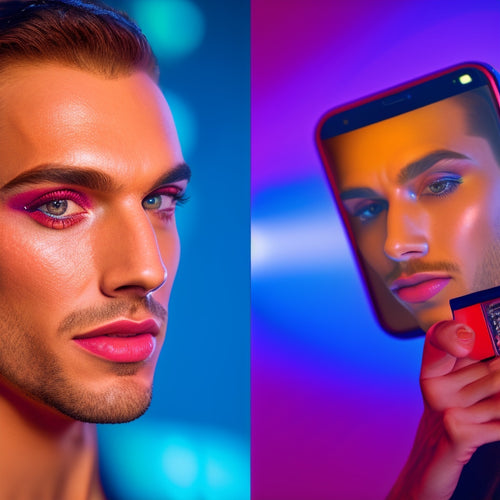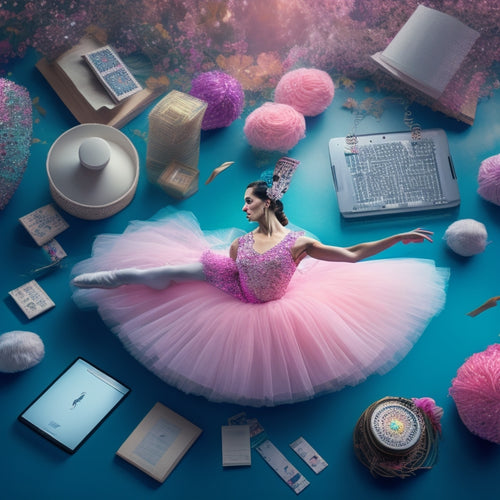
Mastering Movement: Top Online Courses for Photography Enhancement
Share
You're looking to master the art of capturing movement in dance photography. To take your skills to the next level, online courses can help you explore shutter speeds, utilize light and shadow, and enhance dance floor action. You'll learn editing and post-production techniques to highlight your subjects and guide the viewer's attention. Courses will also cover lighting and composition mastery, camera angles, and perspectives to capture the essence of belly dance photography. By mastering these techniques, you'll unleash the full creative potential of dance photography. Next, discover the top online courses to help you refine your skills and reveal the dynamic energy of dance.
Key Takeaways
• Learn to experiment with shutter speeds to capture movement and action in dance photography.
• Understand how to utilize light and shadow to enhance dance floor action and convey emotions.
• Master editing and post-production techniques to accentuate photography subjects and guide viewer attention.
• Develop skills in camera angles and perspectives to create drama, empowerment, and dynamic movement.
• Cultivate cultural sensitivity and artistic vision to create engaging visual narratives in belly dance photography.
Capturing Belly Dance Movement
To effectively capture the fluid movements and intricate gestures of belly dance, you'll want to experiment with shutter speeds ranging from 1/125s to 1/500s to freeze the action and convey the dancer's dynamic energy.
When working with belly dancers, it's crucial to take into account the cultural significance of their costumes, which often feature intricate details and ornate accessories. Be respectful of the dancer's attire and avoid any poses or movements that may be deemed culturally insensitive.
When composing your shots, bear in mind the dancer's costume considerations, such as the flow of fabrics or the sparkle of sequins. These elements can add an extra layer of drama and visual interest to your images.
Additionally, be mindful of the dancer's comfort and safety, ensuring that they're not put in any compromising or unsafe positions. By doing so, you'll not only capture stunning images but also foster a positive and respectful collaboration with your subject.
With practice and patience, you'll be well on your way to mastering the art of capturing belly dance movement.
Editing Tools for Dance Photography
As you venture into editing tools for dance photography, you'll discover the importance of post-production essentials, such as adjusting exposure and contrast to enhance the mood of your images.
Next, you'll learn how to capture dynamic movement by freezing fast-paced action and conveying the energy of the dance.
Post-Production Essentials
With precision editing, you can transform your dance photography from good to exceptional, and that's where post-production essentials come in, empowering you to refine your artistic vision and create visually stunning images that mesmerize your audience.
In this pivotal stage, you'll refine your images, enhancing the mood, atmosphere, and overall aesthetic of your photographs. Color grading, an essential aspect of post-production, allows you to create a consistent visual language throughout your series, elevating your work from amateur to professional.
By mastering color grading techniques, you'll be able to evoke emotions, convey themes, and guide the viewer's attention. Additionally, batch processing will save you time and streamline your workflow, ensuring consistency across your images.
Capturing Dynamic Movement
By leveraging advanced editing tools, you can inject life into your dance photography, capturing dynamic movement that bursts with energy and emotion. To create engaging images, focus on these key editing techniques:
-
Motion blur: Use the 'Orton effect' to create a sense of blur, conveying kinetic energy and dynamic movement.
-
Selective sharpening: Enhance the dancer's body, highlighting muscles and movement, while keeping the background soft and subtle.
-
Color grading: Apply vibrant, bold colors to evoke emotion and energy, drawing the viewer's attention to the dancer's movement.
- Layer blending: Combine multiple images, blending them to create a sense of motion, depth, and dimensionality.
Enhancing Emotional Expression
To evoke the emotional intensity of a dancer's performance, you'll need to master the art of editing tools that accentuate facial expressions, body language, and subtle gestures.
When editing your dance photography, focus on enhancing facial intensity by adjusting the contrast, exposure, and color grading to bring out the subtleties of the dancer's emotions.
Use the 'local adjustments' tool to target specific areas of the face, such as the eyes or lips, to add depth and dimension.
Next, turn your attention to body language, as it conveys just as much emotional information as facial expressions. Adjust the tone and texture of the dancer's skin to highlight the tension or relaxation in their muscles.
Pay attention to the dancer's posture, too, as it can convey confidence, vulnerability, or movement.
Mastering Light and Shadow
As you immerse yourself in the world of photography, mastering light and shadow becomes an essential step in elevating your visual storytelling. Controlling light is vital in capturing stunning images that evoke emotions and convey your message.
To master light and shadow, you'll need to understand the different types of lighting and how to work with them. Here are some key concepts to focus on:
-
Natural Illumination: Learn to harness the power of natural light, whether it's the golden hour, overcast skies, or backlight. Understand how to position your subject to maximize the effect.
-
Artificial Lighting: Familiarize yourself with artificial light sources, such as strobes, flashes, and continuous lights. Know when to use each and how to balance them with natural light.
-
Light Modifiers: Discover how to soften, diffuse, or redirect light using modifiers like umbrellas, softboxes, and reflectors.
- Shadow Control: Learn to manipulate shadows to add depth, dimension, and mood to your images. Practice using shadows to guide the viewer's attention.
Enhancing Dance Floor Action
When you're behind the lens, capturing the energy of a dance floor, you'll need to anticipate and adapt to the dynamic movements of the dancers.
To freeze the perfect pose, you'll want to experiment with shutter speeds, panning, and composition techniques to convey the sense of motion and emotion.
Capturing Dynamic Movement
By employing a combination of slow shutter speeds and panning techniques, you can create visually stunning images that capture the dynamic energy of dancers in motion on the dance floor. To master the art of capturing dynamic movement, follow these essential tips:
-
Experiment with shutter speeds: Slow down your shutter speed to around 1/30s to 1/15s to create a beautiful motion blur, conveying the kinetic energy of the dancers.
-
Panning is key: Follow the dancer's movement with your camera, using a smooth panning motion to create a sharp subject and a blurred background.
-
Pay attention to lighting: Utilize the available light on the dance floor to enhance the mood and atmosphere of your images.
- Anticipate the action: Predict the dancer's next move and position yourself accordingly to capture the perfect shot.
Freezing the Perfect Pose
To enhance your dance floor photography, you'll want to master the art of capturing the perfect pose, which requires a deep understanding of camera settings and dancer movement. By grasping Pose Fundamentals, you'll be able to anticipate and capture the ideal pose, resulting in stunning images that showcase the beauty of dance.
To achieve this, you'll need to understand the intricacies of Model Direction, guiding your dancer to strike a pose that exudes elegance and power.
As you experiment with different camera settings, remember to prioritize safety, ensuring that both you and your model are protected from any potential hazards.
When working with dancers, communication is key. Clearly direct your model, providing specific guidance on pose, posture, and movement. This will enable you to capture the perfect shot, with your dancer frozen in a stunning pose that showcases their skill and artistry.
Post-Production for Belly Dance
Mastering post-production techniques is essential for capturing the essence of belly dance photography. It allows you to refine and accentuate the dramatic curves, flowing fabrics, and mesmerizing expressions that define this enchanting art form.
When editing your belly dance photos, remember to:
-
Respect cultural sensitivity: Be mindful of the cultural context and significance of belly dance. Avoid stereotypes and misrepresentations that might offend the community.
-
Enhance skin tones: Use subtle adjustments to capture the warmth and luminosity of the dancer's skin, without over-editing or altering their natural complexion.
-
Accentuate fabrics and textures: Highlight the intricate details of the costumes, veils, and accessories that add depth and visual interest to your images.
- Balance artistic vision with realism: Strike a balance between creative expression and realistic representation, ensuring that your edits remain true to the spirit of belly dance.
Understanding Camera Angles
As you frame your shot, consider the narrative you want to convey, and strategically position your camera to emphasize the dancer's movements, capturing the dynamic energy of belly dance from a unique perspective.
Mastering camera angles is vital in visual storytelling, allowing you to guide the viewer's attention to specific focal points. Experiment with different angles to add depth and visual interest to your photographs. Try shooting from low or high angles to create a sense of drama or empowerment. You can also experiment with Dutch angles to convey a sense of dynamic movement.
Remember to pay attention to the dancer's body language and positioning, using the camera angle to accentuate their movements. By varying your camera angles, you'll create a visually compelling narrative that draws the viewer in.
Practice makes perfect, so don't be afraid to experiment and try new things. With practice, you'll develop a keen eye for capturing the essence of belly dance through strategic camera placement.
Freeze Frame Dance Moments
Capturing the exact moment when a dancer's body is suspended in mid-air, their muscles tensed and their expression intense, is a hallmark of freezing frame dance moments that convey the dynamic energy of belly dance. As a photographer, you know that freezing these moments requires precision, patience, and practice.
To master the art of freeze frame dance moments, follow these essential tips:
-
Anticipate the action: Study the dancer's movements to anticipate the peak of the action, and be ready to snap the shot.
-
Use a fast shutter speed: A minimum of 1/1000th of a second is recommended to freeze the motion and capture the details of the dancer's pose.
-
Pay attention to lighting: Soft, natural light or strategically placed studio lights can enhance the dancer's form and create dramatic shadows.
- Focus on framing emotions: Capture the dancer's expression, and use the surrounding environment to tell a story, creating a narrative that draws the viewer in.
Bringing Motion to Stillness
By creatively manipulating camera angles, shutter speeds, and panning techniques, you can transform a static image into a dynamic representation of motion, evoking a sense of energy and fluidity. This is particularly important in Motion Studies, where capturing the essence of movement is essential.
To achieve this, experiment with slower shutter speeds to create a sense of blur, conveying the subject's motion. You can also try panning, where you follow the subject with your camera, creating a sense of dynamism.
When shooting, consider using Time Fragmentation, breaking down the movement into smaller, more manageable parts. This allows you to focus on specific aspects of the motion, highlighting the most interesting or dramatic moments.
By doing so, you'll create a more engaging visual narrative, drawing the viewer's attention to the dynamic elements of the image. Remember to stay flexible and adapt to the situation, as the key to capturing motion is to remain open to experimentation and creativity.
With practice and patience, you'll master the art of bringing motion to stillness, elevating your photography skills to the next level.
Frequently Asked Questions
Can I Use a Smartphone Camera for Dance Photography?
Did you know 75% of online content is viewed on mobile devices? You can definitely use a smartphone camera for dance photography! Make mobile adjustments to ISO and shutter speed, experiment with unique camera angles, and get creative with composition to capture stunning dance movements safely and effectively.
Are There Any Free Online Courses for Photography Beginners?
You can find free online courses for photography beginners, focusing on Photography Fundamentals, to develop your Creative Vision. Websites like Coursera, edX, and Udemy offer introductory courses, teaching you the basics of photography, from composition to lighting, to enhance your skills.
How Do I Handle Low-Light Conditions During Indoor Dance Performances?
"As you venture into the dimly lit world of indoor dance performances, imagine yourself as a master navigator, expertly charting a course through low-light conditions with Lighting Essentials and ISO Strategies as your trusty guides."
What Is the Ideal Camera Shutter Speed for Capturing Fast Movements?
When capturing fast movements, you'll want to prioritize speed and reduce blur; aim for a shutter speed of at least 1/1000th of a second to freeze the action, ensuring crisp, sharp images with minimal motion blur.
Can I Edit My Dance Photos Using Free Photo Editing Software?
Like a painter refining a masterpiece, you can elevate your dance photos using free editing software. You can achieve professional results by mastering color grading and noise reduction techniques, ensuring your images shine with vibrant colors and crisp clarity.
Related Posts
-

7 Downloadable Dance Makeup Tutorials for Men
You're about to access a world of bold, edgy, and mesmerizing dance makeup looks with these 7 downloadable tutorials ...
-

7 Time-Saving Hacks for Makeup Artists' Self-Care
As a makeup artist, you know the importance of self-care, but finding time for it can be a challenge. You're not alon...
-

Sfballet: Enhancing Dance Education With E-Papers
SF Ballet is pioneering dance education through innovative e-papers, leveraging digital technology to provide high-qu...


